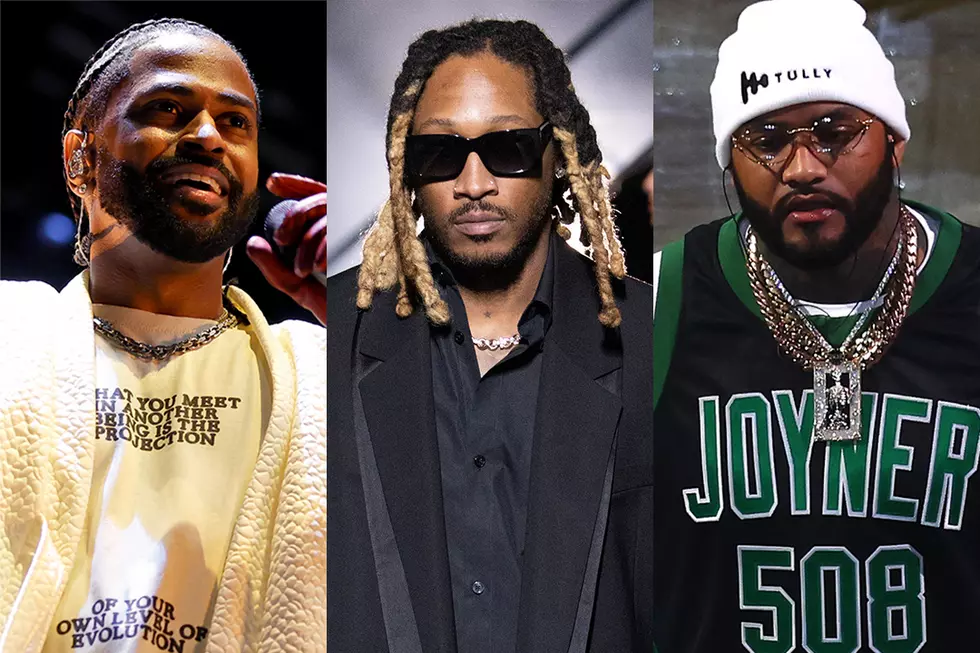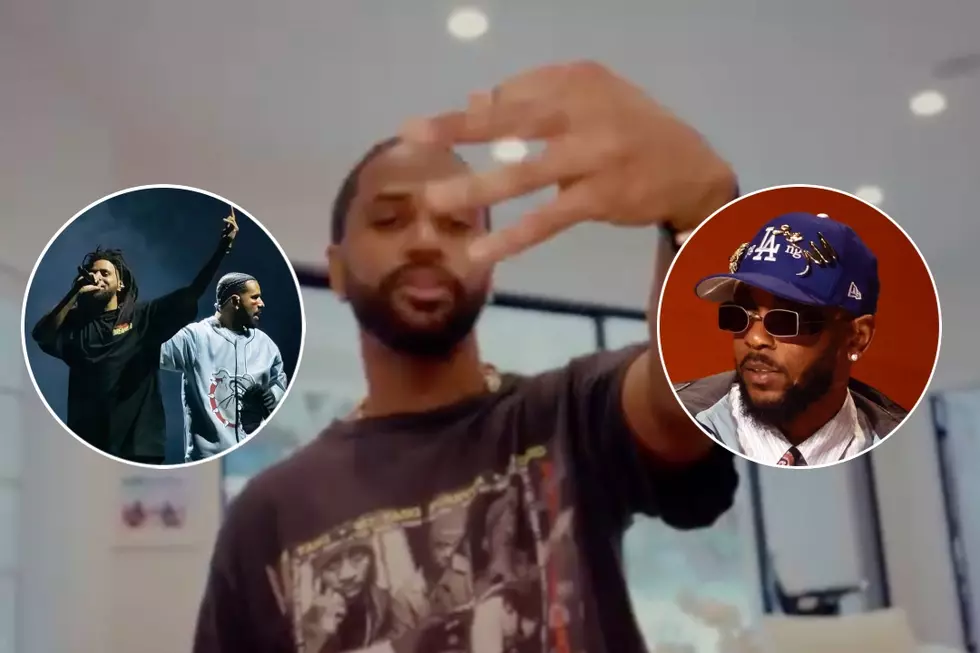![Big Sean: Tenacious D [December/January 2013 Cover Story]](http://townsquare.media/site/812/files/2013/01/BIG_SEAN-6486.jpg?w=980&q=75)
Big Sean: Tenacious D [December/January 2013 Cover Story]
Big Sean slips a custom-made leather baseball jersey over his head and prepares for his first solo xxl cover shoot. the letters stretching across his chest announce his arrival, an essential aspect of his identity, and a message he brings to the world: D-E-T-R-O-I-T.
A few days later, sinking into an enormous dark blue beanbag in the corner of a room at a studio in the Valley Village section of Los Angeles, Sean talks about his aspirations—what he hopes people will be saying about him years from now. “I think people gonna look back and remember that Detroit player,” he says. “Somebody that was reppin’ the D that hard.”
It’s just after 7 p.m. in the celebrity capital of the world. The 24-year-old rapper is surrounded by flat screen TVs and thousands of dollars in recording equipment. Outside, well-manicured landscapes sit behind blossoming fall foliage, while jammed freeways fill bumper to bumper with shimmering luxury vehicles. Some 2,000-plus miles to the Northeast, though, where Sean is from, the picture is a bit bleaker.
Detroit is suffering like no other major city in this country. Though President Obama’s bailout of the auto industry (and Eminem’s awesome Chysler commercials that came as a result) breathed a bit of new life into its downtrodden metropolitan headquarters, there’s waning promise in and around Michigan’s largest city these days. Homes are abandoned, jobs are scarce, crime is high. But it does have rap. Big Sean—the native son signed to Kanye West’s G.O.O.D. Music/Def Jam imprint, has landed five songs in the top five of Billboard’s Rap/Hip-Hop charts in the year and change since his debut album, Finally Famous, hit stores. As he gears up for the release of his sophomore effort, Hall of Fame: Memoirs of a Detroit Player, due in December, Sean knows his success shines like a beacon in dark days. As the first rapper from the Motor City to pop on this scale since Eminem did more than a decade ago, he proudly bears the burden of hope.
“It’s deeper than just comin’ up or making money,” he says. “We got the potential and opportunities to change the world—and still have fun with it. It’s a responsibility that I feel like I’m willing to take.”
Eighteen short months ago, many rap fans doubted that Sean Anderson would ever be in such a position. Back then, it looked more likely that he’d be remembered as “that guy Kanye signed who never came out.” But then, after four years of waiting, three mixtapes, and a moderate 87,000 units sold in its first week out, Finally Famous proved to have longer legs than most of the competition. The hits kept coming: “My Last,” featuring Chris Brown; “Marvin & Chardonnay,” with Kanye and Roscoe Dash-assisted; “Dance (A$$) (Remix)” with Nicki Minaj. Plus a string of memorable guest spots: Wale’s “Slight Work,” Brown’s “Till I Die,” Lil Wayne’s “My Homies Still,” Meek Mill’s “Burn,” and Justin Bieber’s “As Long As You Love Me.”
This summer, any lingering doubts about Sean’s status as G.O.O.D.’s crown prince were quelled by his contributions to the crew compilation, Cruel Summer. Kicking off smash singles like “Mercy” and “Clique,” with verses that stand tall next to those of Kanye, 2 Chainz, Pusha T and Jay-Z.
It hasn’t been lost on Sean, who speaks in soft, humble tones, even as he glows with pride. “I’ve had an awesome year, just in general,” he says. “Just rocking all these goddamn shows, being on all these fresh ass records. It was really a monumental time for me and for the people who was rocking with me.”
This past September, he dropped his latest mixtape, Detroit, which has been downloaded some two million times since. A heady blend of unconventional flows, imaginative annunciation, and ribald rhymes distinguish his songs about love, loss, and chasing success—solidifying a brash, witty, artistic persona that’s been developing for years.
“Sean has chose to live his life in a certain way,” says veteran executive Kevin Liles, who took management of the young MC’s career two years ago. “He’s a Detroit player. Every day of his life, he defines it as, ‘What would a Detroit player do?’”
All those bouncy, party-happy singles would suggest that those days are filled mostly with partying and, well, playing. But Sean’s intent is on reaching greater depth with his new music. “I took all my experiences from Detroit and incorporated them into who I am today,” he says. “From partying to inspiration to sharing times about being broke to love to the dope boys, paper chasers. I would see all the players rocking furs and gators. I’ve seen people get killed. I’ve seen people spend crazy money. I’ve seen poor people. I give every aspect of the city in my music. They need somebody to tell that story.”
Currently, that story is one that’s often rather grim. Sean’s mom, Myra Anderson, a woman he credits as his greatest influence, speaks on the phone from the D, where she’s waiting for renovations to be completed on the suburban condo her son bought her. “We don’t have a major department store in the city anymore,” she says, with a sigh. “We don’t have a major grocery store chain. It’s kind of bad right now.”
That may be an understatement. In 2008, Mayor Kwame Kilpatrick, during his second term in office, became entangled in accusations of corruption and resigned after pleading guilty to two counts of obstruction of justice. In 2010, he was sentenced to five years in prison for violating probation. The city’s violent crime has dipped 10 percent this past year, but still remains five times above the national average.
In November, city officials warned that the city was in danger of running out of cash before the New Year.
The government’s woes reflect those of the city’s citizens. The most recent Census found that 35 percent of Detroit’s 750,000 residents, 83 percent of whom are Black, are living below the poverty rate. That first number is staggering. Up almost 10 points in the past decade, it’s two and a half times the national average of 14 percent. Chicago and Baltimore, by way of comparison, have poverty rates of 21 percent. New York’s sits at 19 percent.
Meanwhile, more than a quarter of Detroit’s inhabitants are younger than the age of 18. Those are the very same youths that make up a bulk of Big Sean’s demographic. The very same youths who are subjected to a deteriorating local infrastructure and public school system—85 former school buildings are currently listed for sale on the Detroit Public Schools’ website. It’s an initiative reflective of the problems, the rampant closings, but also the effort to redevelop and rejuvenate. Sean, too, through action and music, aims to help.
“It’s getting to the point where I really wanna just start giving back to the city,” he says, noting his recently founded Sean Michael Anderson Foundation, which his mother helps to run. “They closed more than 20 schools in Detroit. It really inspired me to do better and try and contribute what I can. I saw [former NBA star] Jalen Rose opened up his own school, and that was inspiring to me like, ‘Damn, maybe I can do that one day.’ I ain’t super rich or nothin’, but I’m probably way more well off than a lot of people.”
It’s the type of thing that does a mother’s heart good. “I’m really proud of him because he really wants to give back,” says Mrs. Anderson, whose work with the foundation focuses on aiding school-aged children in Wayne County, where Detroit is, as well as neighboring Oakland County and Macomb County. “He kind of had mentioned this maybe a year and a half ago how, ‘Maybe I can do a concert and donate the money.’ So we started kicking things around and out of that the foundation is coming. He feels he can use his following and his influence to bring attention to things here in the area.”
That influence has already proven far-reaching. Among fans and peers, he’s pioneered rhyme styles (most notably, the now ubiquitous word-skipping simile, i.e.,“…Line after line after line/Barcode…”), fashion trends (TI$A snapbacks, handkerchief in t-shirt pocket), and ushered in new hip-hop lexicon through playful adlibs (“Boi,” “Swerve,” “Oh God.”). Liles sees the possibilities of Sean’s platform, too. “It’s what we heard when we first heard about Master P or Cash Money,” he says. “And when we first heard about Def Jam, and when we first heard about Roc-A-Fella, or Too $hort. The way that people told the truth that they were livin’—not what somebody else was livin’, but the way they were livin’. I think Sean gives that perspective, from Detroit.”
Mrs. Anderson’s maternal sense of protectiveness comes to the fore. “I don’t want to lay the weight of the world on him, or the weight of the city,” she says. “How’s that saying go? To those whom much is given, much is expected. I believe we are really all one, and we are all connected. That’s probably something I’ve passed on to Sean.”
Sean sees his success as an extension of his youth. It’s how he was raised. “I just find myself like an honest son of the city. I’m somebody who grew up in the ’hood, had a good head on my shoulders, always did good in school, always would put my mind to something and get it done.”
It’s now inching towards midnight in L.A. As a Key Wane-produced beat for a song, tentatively titled “Dreams,” plays on a loop, Big Sean vibes and mouths potential lyrics to himself. It’s about half finished. The first verse recounts that now-famous day in 2006 when he first rapped for Kanye. The one he’s working on will tell the tale of student becoming a teacher—as a younger, eager MC approaches Sean, busts a rhyme, and hopes for a shot. Sean hopes to one day be able to give it.
It’s that kind of duty to give back, to pay it forward, to lead, that he feels for his city, too.
“I was sitting talking to Jay after his Barclays show at the Brooklyn arena,” he says, recalling the huge opening-night ceremony that took place in October—a homecoming that served as a coronation. “And it was like, ‘That’s what I wanna be for Detroit.’” He pauses, as if to consider the hits, the trends, the impending second album, the clothing line, the foundation—and thinks about something like bringing a stadium and pro sports franchise to your city, all those jobs, all that money, all that pride. The mission remains.
“I wanna be that hero.”
More From XXL









